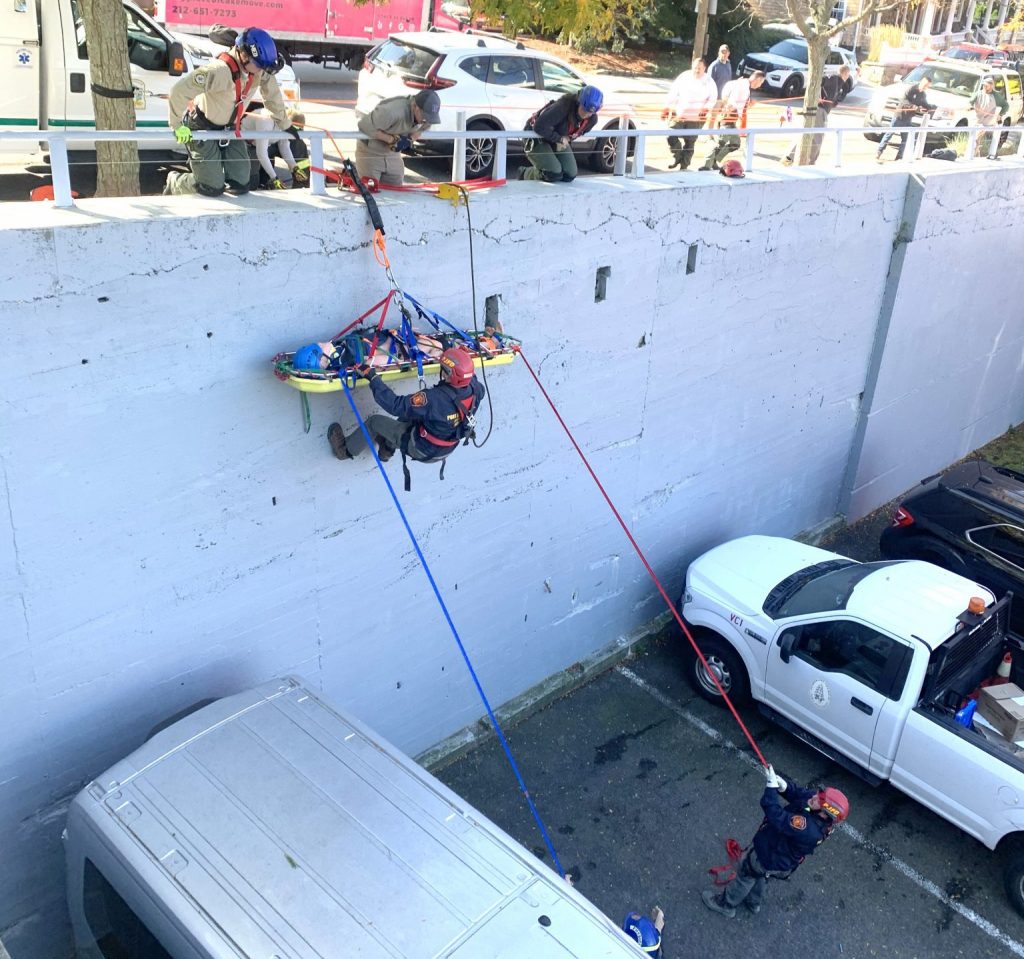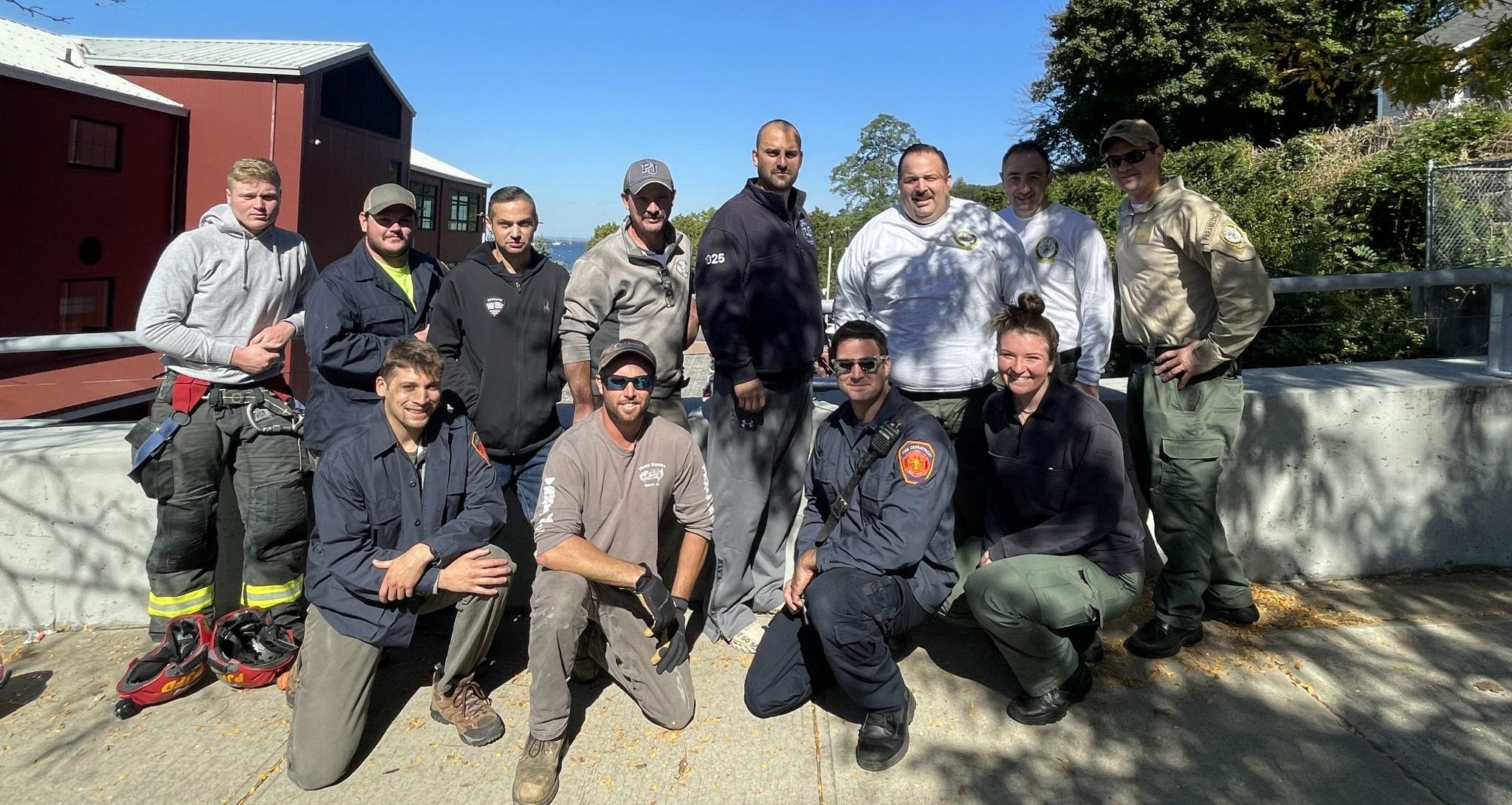By Julianne Mosher
It takes a village – literally.
Located on opposite sides of Port Jefferson, the Port Jefferson Fire Department and Port Jefferson EMS recently converged outside the Village Center at Harborfront Park for a training exercise that was quite the spectacle.
A dozen volunteers from both agencies staged a scenario Sunday, Oct. 9, in which a person “fell” over the ledge of a nearly 40-foot wall, located on East Broadway, and said the “patient” could only be accessible by lowering a rescuer down to get them.
Christian Neubert, third assistant chief of the PJFD, noted a real-life example using this technique could be if someone were to fall into an open construction area with a finished basement but no stairs.
So, to train for an instance like this, the two groups strapped up individual rescuers from both the fire department and EMS, and lowered them down using a rope to the parking lot below to assess, package and retrieve the patient.

Back above, other volunteers created a five-to-one haul system to pull both the patient and rescuer back to safety.
These specific agencies coordinate frequently on different types of calls, as many fire departments and EMS often do. But Michael Presta, deputy chief of the Port Jefferson EMS, said that the partnership between Port Jeff’s fire department and the separate EMS — which supports not only the village, but provides services to Belle Terre, Mount Sinai and Miller Place — has been ongoing for quite a few years, and this technical rescue training they practiced on Sunday is an indicator on how these two teams can work together.
“There’s a lot of fire departments that provide technical rescue services in a confined space — different kinds of specialty disciplines — but there’s not a lot of patient care centered activity that goes on in a lot of these places,” Presta said. “We had a great conversation a few years ago and said, ‘Hey, it’d be really great to work together jointly with both departments and work on getting paramedic-level care down to these patients.’”
Presta said that not every scenario is the same when it comes to an emergency. People might be trapped somewhere for an extended period of time or have a complicated injury that requires care, pain management, airway management or bleeding control in a technical rescue environment.
“We thought, ‘What better way than to get the paramedics, train them in technical rescue and get them down to those patients?’” he said.
Neubert added this type of training is not easy. “There’s a lot of knowledge and skill that has to go into it, and you need to have the type of student that is ready to learn,” he said. “It’s different than basic firefighting skills.”
And Sunday’s training created an atmosphere allowing both firefighters and paramedics to work together as a team.
“It doesn’t matter what organization you were volunteering from,” Neubert said. “When we started that drill the other day, we gave the scenario, they found the job that needed to get done and they just did it.”
And once that patient is secured by whichever volunteer is first on scene, paramedics begin to administer the care that someone would find in the hospital emergency room right on the spot.
Technical service rescues might seem niche and relatively rare, but Presta said that one could really never know.
“In this small little community here, we have a couple of hospitals, we have a power plant, train station, major transportation, the ferry. So, there are a lot of opportunities, I’d say, for people to get injured in very tricky situations,” he said. “Whether you’re down in the engine room of a ship, or in a confined space in a power plant or injured on the roof of the hospital, in this community there could be a lot of opportunities.”
Neubert added, “Something as simple as a broken leg on the bluffs out in the cove … that’s not necessarily the same as a 40-foot wall, but it still involves rope, timing concepts and technical rescue.”
After a successful 90-minutes, and a spectacle for shoppers at the local farmers market across the park, Presta and Neubert were both satisfied with the day’s events.
“This type of training will give us the ability to help other agencies,” Presta said. “Now we’re able to provide a specialty resource like this, and they have the ability to call on us if they don’t have that training or ability or equipment. We can bring it.”







